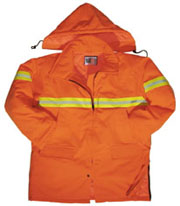

FRONT PAGE
OPS. INDEX
 |
 |
FRONT PAGE |
OPS. INDEX |
It is highly recommended that WICEN participants wear high visibility clothing whilst on activities. As a minimum, a vest with reflective strips to Australian Standard 4602:1999 suitable for day and night use.
The WICEN recommended colour is red-pink, being the most suitable for the environments in which the majority of our activities take place (see below).
|
Visibility High visibility can either be a help or a hindrance for emergency responders. For example, in hazardous situations, it is critical that emergency responders can easily be seen. Couple this with the fact that hazardous material emergencies often do not occur in well-lit environments, and the need of high visibility is an important feature in chemical protective apparel. The colors chose for Dupont fabrics were based on extensive visibility research. For example, the lime yellow and safety yellow colors of Tychem fabrics can be seen in a wider range of the visible spectrum than other garments. |
"Itís a legal requirement people on skid sites wear high visibility
clothing, but the research showed fluorescent yellow-green colours usually
found on such clothing often gave us false warnings because yellow-green are
common colours in New Zealand industrial forestry environments," Alan says. "Our study determined red-pink high visibility colours, less common in nature, could be searched for without false warnings using our system. The downside of this was some colour-blind workers had difficulty distinguishing pink. Subsequently, a multi-coloured solution including both yellow-green and red-pink may be recommended," he says. |
||||||||||||||||||
|
ANSI 107-1999 At a
Glance Garments:
Class 3 applies to workers:
Class 2 applies to workers:
Class 1 applies to workers:
|
Modelled after the
European Standard (EN-471), the ANSI-107 Standard is specifically designed
to help not only the consumer, but also the manufacturer to design apparel
that meets certain specifications regarding fluorescent and reflective
qualities. There are three types of conspicuity classes, based upon the
users' activities, that are specified by ANSI-107: Class 1: For users who have ample separation from vehicular traffic that doesn't exceed 25 mph and where background is not complex. This category may include some law enforcement and emergency medical personnel, sidewalk maintenance workers, and delivery vehicle drivers. Class 2: Recommended for users who need greater visibility in inclement weather conditions, whose activities are near roadways where traffic speeds may exceed 25 mph. This class is more indicative of county or city workers, including railway workers, school crossing guards, parking and tollgate personnel, airport ground crew, emergency medical personnel and law enforcement directing traffic. Class 3: These garments provide the highest level of conspicuity for workers with high task loads in high-risk areas, such as wide-ranging weather conditions or locations with traffic speeds in excess of 50 mph. Class 3 garments are recommended for all roadway construction personnel and vehicle operators, utility workers, survey crews, emergency response teams, railway crews and accident site investigators.  Each
class specifies the square inches of a fluorescent and reflective material
to be used, along with the three colors--orange, yellow-green and red.
Specific standards are issued regarding the color range being within an X
and Y range. Each
class specifies the square inches of a fluorescent and reflective material
to be used, along with the three colors--orange, yellow-green and red.
Specific standards are issued regarding the color range being within an X
and Y range. |